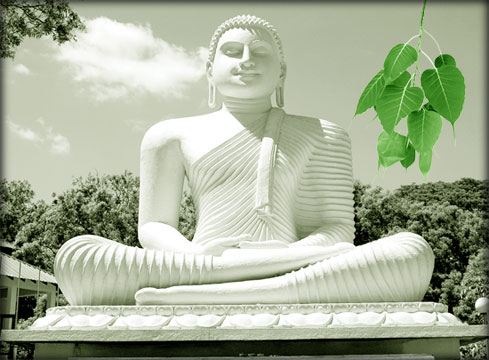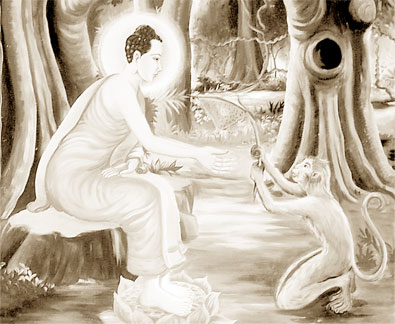|
Tomorrow is Unduvap Full Moon Poya Day:
Buddhist viewpoint on animal rights
By Lionel Wijesiri
 |
|
A Buddha statue in
Polonnaruwa |
“All beings tremble
before violence. All fear death. All love life. See yourself in others.
Then whom can you hurt? What harm can you do?”
- Dhammapada
Buddhism wholeheartedly supports the view that all living creatures
must be respected. The first precept itself has a direct bearing on the
treatment of animals. It prescribes non-violence, not just towards human
beings, but to all prana or living beings.
There are a number of other instances where the Buddhist values of
non-violence and compassion are clearly expressed. The Sutta Nipata
states: “Let him neither kill, nor cause to be killed any living being,
or let him approve of others killing, after having refrained from
hurting all creatures, both those that are strong and those that tremble
in the world.”
In the Eight-fold path, abstaining from violence is a major
requirement. Right Action (Samma Vayama) includes abstaining from the
taking of life. It adds: “He dwells with his rod laid down, his knife
laid down, scrupulous, kind, compassionate for the welfare of all living
beings.”
Right Livelihood (Samma Ajiva) prescribes the practitioners not to
engage in trades or occupations which, either directly or indirectly,
result in harm for other living beings. The Karaniyametta Sutta says:
“Whatever living beings there may be - feeble or strong (or the seekers
and the attained), long, stout, or of medium size, short, small, large,
those seen or those unseen, those dwelling far or near, those who are
born as well as those yet to be born - may all beings have happy minds.”
The Nandivisala Jataka illustrates how kindness should be shown to
animals domesticated for human service.
Modern science reveals that in some respects, animals are superior to
humans. Dogs have a keener sense of hearing; insects have a keener sense
of smell; hawks are speedier; eagles can see a greater distance.
Dolphins have the ability to communicate through echo sounding.
Hyenas use smell-based networking, and the marmoset monkeys are so
cultivated that they have figured out ways to have a polite
conversation.
These qualities are things that humans still struggle to follow.
Undoubtedly, men are wiser; but men have so much to learn from the ants
and bees. Much of the animal is still in us. However, we also have much
more: We have the potential for spiritual development.
Buddhists are encouraged to love all living beings and not to
restrict their love to human beings. They should practise loving
kindness towards every living being. The Buddha’s advice is that it is
not right for us to take away the life of any living being since every
living being has a right to exist.
Asoka
Concern for animals is attested back to the beginnings of Buddhist
history. The first Buddhist monarch of India, Asoka (268-223 BC)
includes in his Edicts an expression to put an end to the killing of
animals. He also includes animals with humans as the beneficiaries of
his programs for obtaining medicinal plants, planting trees and digging
wells.
Emperor Asoka also taught his people to have compassion for animals
and to refrain from harming them. In one of his famous pillar edits, he
declares, “I have enforced the law against killing certain animals. The
greatest progress of righteousness among men comes from the exhortation
in favour of non-injury to life and abstention from killing living
beings.” The fact that Buddhists consider that all animals are sentient,
and that just like us, they are capable of suffering is of great
importance concerning animal rights issues.
Realms
In Buddhism, there are six realms in the cycle of rebirth into which
sentient beings may be born: Devas (gods), Asuras (titans or demons),
Pretas (hungry ghosts), Narakas (hell beings), Tiryakas (animals) and
Manushyas (humans). For this very reason, Buddhism looks upon life in
the universe as a totality which has, by itself, a right to exist
unhindered, with no threats of destruction from outside to serve the
needs of any single person or group, whether they be under the direction
of any human or divine authority. It is considered that the harmonious
continuance of the universe does not permit or allow such crude and
clumsy handling of Mother Nature.
 |
|
The painting depicts a
monkey offering the Buddha some honey |
In the Dhammapada, this idea is expressed as follows.
All living things fear being beaten with clubs,
All living things fear being put to death,
Putting oneself in the place of the other,
Let no one kill nor cause another to kill.
Buddhism also offers definite and positive instructions with regard
to the manner in which humans should develop universal loving kindness
towards all living things that exist in the universe, whether in close
proximity or at a distance, seen or unseen, large or small, fierce or
timid. Even foetal bodies of unborn babies or those in the stage of eggs
are encompassed within this range of universal loving kindness or Metta
in Buddhism. It specifies this attitude, thus declaring ‘May all beings
be well and happy!’ Sabbe satta bhavantu sukhitatta.
Kinship
There is, in Buddhism, more sense of kinship with the animal world, a
more intimate feeling of community with all that lives, than is found in
Western religious thought. It is rooted in the total Buddhist concept of
life. It is an essential part of the all-embracing Buddhist philosophy
which neglects no aspect of experience, but extends the concept of
personal evolution to all forms of sentient life. The kitten on the lap
and the uninvited cobra on the bed are all part of a world, which which
may not be the best of all possible worlds.
However, the universe was not brought into existence solely for man,
his convenience and enjoyment. The place a human being occupies in it is
one he has created for himself, and he has to share it with other
beings, all of them motivated by their own laws of being and the will to
live. That is the reason why in the Buddhist texts, animals are always
treated with great sympathy and understanding.
Buddhism shows that both animals and human beings are the products of
ignorance conjoined with craving, and that the differences between them
are the consequences of past karma. In this sense, though not in any
other, “all life is one.” It is one in its origin, ignorance craving,
and in its subjection to the universal law of causality.
However, every being’s karma is separate and individual. So long as a
man refuses to let himself be submerged in wrongdoings, so long as he
resists the pressures that are constantly brought to bear on him to make
immoral decisions, he is the master of his own destiny. Whatever the
karma of others around him may be, he need have no share in it. His
karma is his own, distinct and individual. In this sense, all life is
not only one, but each life, from the lowest to the highest in the
scale, is a unique current of causal determinants. The special position
of the human being rests on the fact that he alone can consciously
direct his own personal current of karma to a higher or lower destiny.
All beings are their own creators; man is also his own judge and
executioner. He is also his own saviour. |

